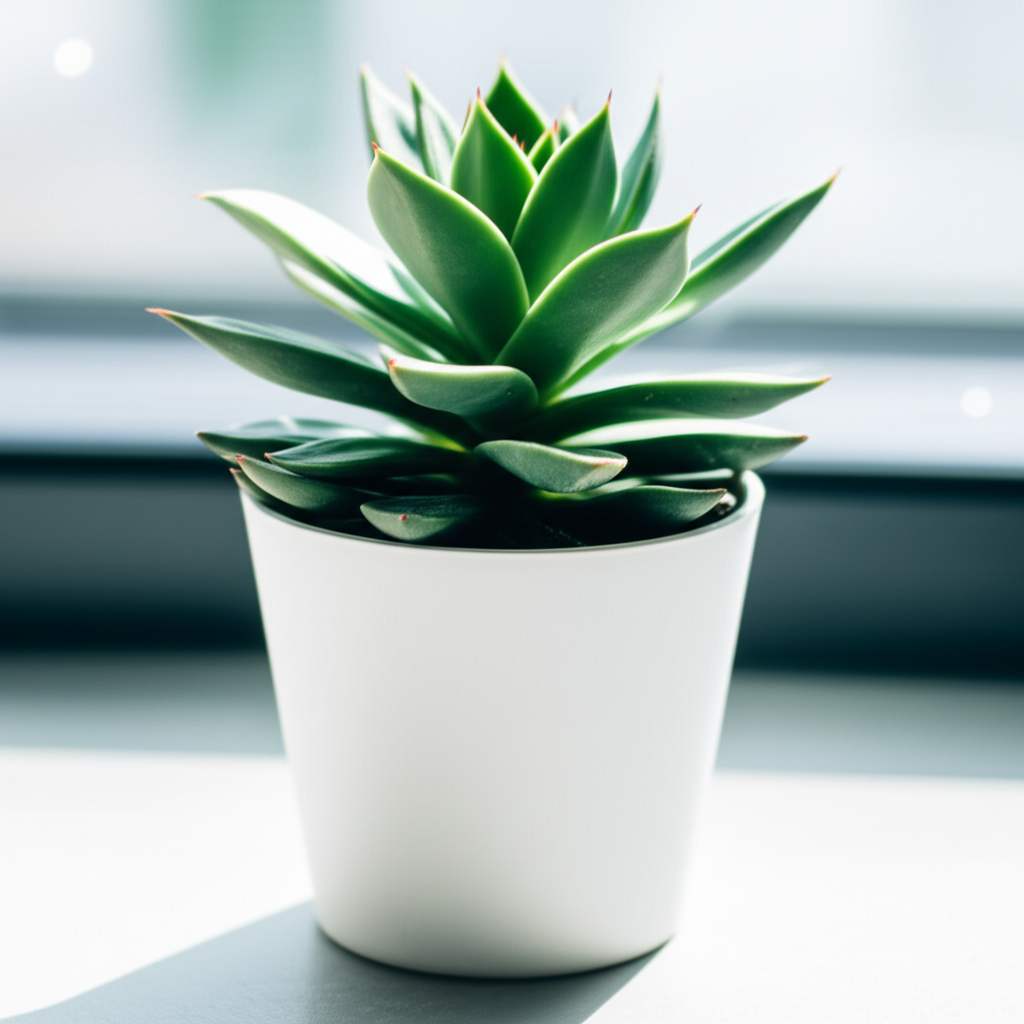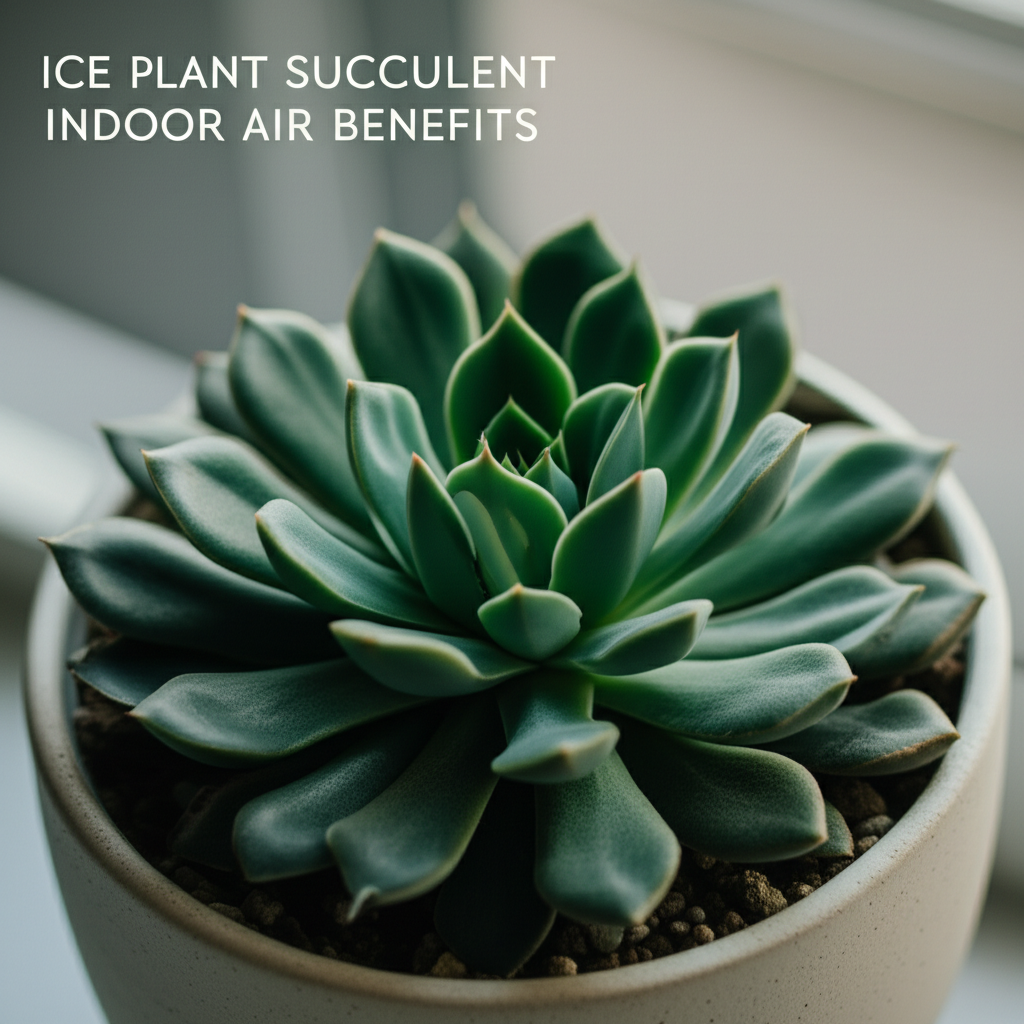The Subtle Symphony of Indoor Air Quality
In our quest for healthier living spaces, the focus has often been on ventilation, humidifiers, and air purifiers. However, a more organic and aesthetically pleasing solution has been quietly gaining recognition: houseplants. Among the diverse botanical world, succulents have captured the hearts of many with their low-maintenance nature and unique forms. One particular group, the Ice Plant succulents, also known as members of the Aizoaceae family, offers a surprising array of benefits, most notably their positive impact on indoor air quality. While often celebrated for their resilience and visual appeal, the contribution of these fascinating plants to a healthier home environment is a story worth telling. This article delves deep into the science and practical advantages of incorporating Ice Plant succulents into your indoor sanctuary, exploring how they can subtly yet significantly improve the air you breathe.
What Exactly Are Ice Plant Succulents?
Before we explore their air-purifying prowess, it’s essential to understand what defines an Ice Plant succulent. This broad category encompasses a vast number of species characterized by their succulent leaves, which are often swollen and fleshy, adapted to store water in arid environments. The “ice plant” moniker often refers to those species with papillae (tiny, bladder-like structures) on their leaf surfaces that can glisten and refract light, resembling ice crystals. Common examples include Delosperma, Mesembryanthemum, and various Lithops (living stones), though many other genera fall under this umbrella. Their diverse appearances range from sprawling groundcovers to striking, pebble-like forms, making them a versatile choice for any plant enthusiast.
The Science Behind Plant-Powered Air Purification

The concept of plants purifying indoor air isn’t new. The foundational research, famously conducted by NASA in the 1980s, identified common houseplants capable of removing volatile organic compounds (VOCs) from the air. VOCs are ubiquitous in our homes, emitted from furniture, cleaning products, paints, and even everyday activities. Exposure to high levels of VOCs can lead to a range of health issues, from headaches and dizziness to more serious respiratory problems and long-term health effects.
How Plants Tackle VOCs
Plants primarily purify air through two main mechanisms:
- Photosynthesis: While the primary role of photosynthesis is to convert light energy into chemical energy for the plant, it also involves gas exchange. Plants take in carbon dioxide and release oxygen. During this process, they can also absorb certain airborne pollutants.
- Phytoremediation: This is the biological process by which plants absorb, accumulate, and break down pollutants. Microorganisms in the soil and on the plant’s roots also play a crucial role, further breaking down absorbed toxins.
Ice Plants and Their Unique Contribution
While many succulents are known for their CAM (Crassulacean Acid Metabolism) photosynthesis, which allows them to open their stomata (pores) at night to absorb CO2 and minimize water loss during the day, this mechanism also has a direct impact on air quality. Unlike plants that release CO2 at night, CAM plants like many Ice Plants absorb CO2 during the cooler, more humid hours of the night. This means they are actively drawing in carbon dioxide and, by extension, can contribute to the removal of other airborne gases during this period.
The Role of Stomata and Leaf Surface
The specialized structure of Ice Plant succulent leaves, particularly the papillae in some species, can also play a subtle role. These structures can increase the surface area for gas exchange and potentially trap airborne particles, which can then be processed by the plant or its associated microorganisms.
Key Air-Benefiting VOCs Addressed by Houseplants (Including Succulents)
While specific studies focusing solely on Ice Plant succulents’ VOC removal are less abundant than for more common houseplants like snake plants or spider plants, their succulent nature and CAM photosynthesis place them within the broader category of beneficial air-purifying plants. The common VOCs targeted by houseplants include:
- Formaldehyde: Found in many building materials, furniture, and cleaning products.
- Benzene: Emitted by paints, plastics, and synthetic fibers.
- Xylene: A common solvent found in paints, varnishes, and adhesives.
- Toluene: Similar to xylene, found in solvents, paints, and glues.
- Ammonia: Released by some cleaning products and also found in cigarette smoke.
Comparing Ice Plants to Other Houseplants
It’s important to note that the rate at which different plants purify air can vary significantly. While a single plant might not drastically alter the air quality in a large room, a collection of plants working in synergy can create a noticeable difference. Ice Plant succulents, with their efficient water management and unique metabolic pathways, are valuable contributors to a biodiverse indoor ecosystem that promotes cleaner air.
Beyond VOCs: Additional Air Quality Benefits
The positive impact of Ice Plant succulents extends beyond the direct removal of harmful chemicals.
Increased Humidity
Transpiration, the process by which plants release water vapor from their leaves, naturally increases the humidity levels in a room. In dry indoor environments, especially during winter months when heating systems are in use, this can be a significant benefit. Proper humidity levels can help alleviate dry skin, chapped lips, and irritated sinuses. While succulents are known for their drought tolerance, they still transpire, contributing to a more comfortable atmospheric balance.
Oxygen Production
As mentioned earlier, photosynthesis is a fundamental plant process that involves the uptake of carbon dioxide and the release of oxygen. While the amount of oxygen produced by a few houseplants is unlikely to dramatically alter the overall oxygen content of a room, it contributes to a more natural and refreshing atmosphere.
The Psychological Impact of Greenery
While not a direct chemical benefit, the presence of plants has a profound psychological impact on our well-being. Studies have shown that being around plants can reduce stress, improve mood, and enhance cognitive function. This “biophilia” – our innate connection to nature – can indirectly contribute to a healthier living environment by fostering a sense of calm and well-being.
Incorporating Ice Plant Succulents for Optimal Air Benefits
To maximize the air-purifying potential of your Ice Plant succulents, consider these practical tips:
- Placement is Key: While succulents generally prefer bright light, placing them in areas where you spend most of your time, such as living rooms or home offices, will allow you to benefit from their air-enhancing properties more directly.
- Group Them Together: As with many air-purifying plants, the collective effect is often greater than the sum of individual plants. Creating a small “plant corner” can amplify their impact.
- Proper Care: Healthy plants are more efficient at purifying air. Ensure your Ice Plants receive adequate light, are watered appropriately (allowing soil to dry out between waterings), and are free from pests.
- Choose a Variety: Different species may have slightly different capabilities. Experiment with various Ice Plant succulents to see which ones thrive in your environment and contribute most to your home’s ambiance.
Key Facts and Comparison: Ice Plant Succulents vs. Other Air-Purifying Plants
To provide a clearer perspective, let’s compare Ice Plant succulents to some other popular air-purifying plants.
| Feature | Ice Plant Succulents | Snake Plant (Sansevieria) | Spider Plant (Chlorophytum comosum) | Peace Lily (Spathiphyllum) |
|---|---|---|---|---|
| Primary Air Purification Mechanism | CAM Photosynthesis (CO2 uptake at night), Phytoremediation | CAM Photosynthesis (CO2 uptake at night), Phytoremediation | Photosynthesis, Phytoremediation | Photosynthesis, Phytoremediation |
| VOCs Primarily Targeted | Formaldehyde, Benzene, Xylene, Toluene (general) | Formaldehyde, Benzene, Xylene, Toluene, Trichloroethylene | Formaldehyde, Benzene, Xylene, Toluene | Formaldehyde, Benzene, Xylene, Toluene, Ammonia |
| Humidity Contribution | Moderate (via transpiration) | Low (minimal transpiration) | Moderate | High (significant transpiration) |
| Light Requirements | Bright, indirect to direct light | Low to bright, indirect light | Low to bright, indirect light | Low to medium, indirect light |
| Watering Needs | Drought tolerant, allow soil to dry out | Drought tolerant, allow soil to dry out | Moderate, keep soil slightly moist | Keep soil consistently moist |
| Ease of Care | Very easy | Very easy | Easy | Moderate |
Steps to Enhance Your Indoor Air with Ice Plant Succulents
Taking actionable steps to integrate Ice Plant succulents into your home for improved air quality is straightforward.
Step-by-Step Implementation
- Assess Your Space: Identify areas in your home that could benefit from improved air quality and where plants can thrive (considering light availability).
- Choose Your Ice Plants: Select species that appeal to your aesthetic and are suitable for your indoor conditions. Consider variations in leaf texture and growth habit.
- Select Appropriate Pots: Opt for pots with drainage holes to prevent root rot, a common issue with overwatering succulents.
- Use Well-Draining Soil: A specialized cactus or succulent potting mix is ideal, providing the necessary aeration and drainage.
- Position for Success: Place your plants in locations that receive adequate light. South-facing windows are often ideal for most succulents, but East or West-facing windows can also work.
- Establish a Watering Schedule: Water thoroughly only when the soil is completely dry. This might be every few weeks, depending on your home’s humidity and temperature.
- Monitor and Maintain: Observe your plants for signs of stress (like yellowing leaves or mushy stems) and adjust care accordingly. Dusting leaves gently with a soft brush can also help them function more efficiently.
Pros and Cons of Using Ice Plant Succulents for Air Quality
Understanding the advantages and potential drawbacks is crucial for making informed decisions.
| Pros | Cons |
|---|---|
| Low maintenance and drought tolerant, making them ideal for busy individuals or beginners. | May not purify air as rapidly as some leafy tropical plants for certain VOCs. |
| Contribute to improved air quality through CO2 absorption (especially at night) and potential VOC breakdown. | Require bright light, which may limit placement options in some homes. |
| Can increase indoor humidity through transpiration. | Some species can be toxic if ingested by pets or small children, so careful placement is advised. |
| Aesthetically pleasing, adding visual interest and a touch of nature to interiors. | Overwatering is a common mistake that can lead to root rot and plant death. |
| Contribute to a sense of well-being and reduce stress through biophilia. | The specific air-purifying capabilities of many Ice Plant species are not as extensively studied as more common houseplants. |
Dispelling Myths: The Realistic Impact of Houseplants
It’s important to approach the topic of indoor air purification with realistic expectations. While houseplants are beneficial, they are not a magic bullet for severe air pollution.
What Houseplants Can and Cannot Do
- Can: Contribute to a reduction in VOCs, increase humidity, produce oxygen, and improve overall well-being.
- Cannot: Completely eliminate all airborne pollutants, compensate for severe ventilation issues, or replace the need for regular cleaning and maintenance of your home environment.
The scientific consensus is that to achieve significant air purification, you would need a very large number of plants, often exceeding what is practical for most homes. However, the cumulative effect of even a few well-cared-for plants, including your Ice Plant succulents, undeniably contributes to a healthier and more pleasant living space.
Conclusion: A Greener, Fresher Home with Ice Plant Succulents
In conclusion, Ice Plant succulents offer a unique and beautiful way to enhance your indoor environment. Beyond their striking visual appeal and ease of care, they play a valuable role in subtly improving indoor air quality. Through their CAM photosynthesis, transpiration, and the potential for phytoremediation, they contribute to a more balanced and breathable atmosphere. By understanding their benefits and implementing them thoughtfully into your home, you can cultivate a greener, fresher, and healthier living space, one ice plant at a time. Embrace the quiet power of nature and breathe a little easier with these resilient and rewarding botanical companions.


